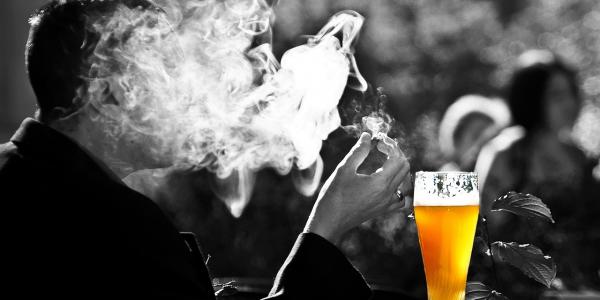Different kinds of problems

Alcohol problems fall into 4 basic categories.
Generally speaking, alcohol problems fall into 4 basic categories:
1. Binge Drinking
2. Alcohol Use Disorder-Mild
3. Alcohol Use Disorder-Moderate
4. Alcohol Use Disorder-Severe
Binge Drinking
Binge drinking is drinking heavily in a short space of time to get drunk or to feel the effects of the drink. The amount of alcohol that someone needs to drink in order to be classified as “bingeing” is a bit hard to define, but the standard defined by the National Institute on Alcohol Abuse and Alcoholism (NIAAA) is drinking more than the daily recommended drinking limit.
- For men, that means drinking five (5) or more standard drinks at one sitting in a row, which would be like drinking three pints of a strong beer.
- For women, that means drinking four (4) or more standard drinks in one sitting in a row, or two large, full glasses of wine in a short amount of time.
Now, that might not sound like too much, but remember that one standard drink is 0.6 fluid ounces of alcohol, which is how much is in one can of regular beer (with an alcohol content of 5%). So, drinking 5 standard drinks is consuming 3 fluid ounces of alcohol. Drinking a pint is like drinking a bottle and a half of beer, and if it’s a stronger beer like a craft beer, the alcohol content is typically even higher for every one beer.
Drinking that much alcohol in a short space of time – let’s say one hour – will raise your blood alcohol content (BAC) quickly because you’re not giving your body time to metabolize what you're putting in there, making you more drunk very quickly. Drinking the same amount of alcohol over the course of an evening will not have the same effect on your BAC.
"But," you say, "that’s the point!" You drink that much and that quickly because you want to get a quick buzz on. The trouble is that studies show that binge drinking actually may be significantly worse for your health and well-being than drinking small quantities more frequently. Here are some examples:
- Accidents and falls are common among binge drinkers. Being drunk affects your balance and coordination, so binge drinkers are more likely to fall down and get banged up than drinkers who spread out their drinking (Gmel, et al., 2006).
- Crime. Binge drinking leads to drinkers being both victims and perpetrators of various types of crimes, including vandalism, theft, and violence (Parliamentary Office of Science and Technology, 2005).
- Health Effects. Binge drinking can also cause a whole host of problems for your body, including heart, blood pressure, white blood cells, female reproductive hormones, and even brain damage (World Health Organization, 2018)!
Alcohol Use Disorders
Drinking that becomes problematic is given the diagnosis of “alcohol use disorder” (AUD). AUD is a chronic brain disease characterized by habitual alcohol use, loss of control over alcohol consumption, and a negative emotional state when not using alcohol (National Institute on Alcohol Abuse and Alcoholism, 2018).
Professionals diagnose AUD by referring to specific criteria outlined in the Diagnostic and Statistical Manual of Mental Disorders (DSM) compiled by the American Psychiatric Association (APA). In May of 2013, the APA released the 5th edition of the DSM which, as of this writing, is their most current edition. In terms of diagnosis, the DSM-5 categorizes AUD on a continuum of mild, moderate, or severe (American Psychiatric Association, 2013).
Symptoms of Alcohol Use Disorder
The following are the 11 symptoms published in The Diagnostic and Statistical Manual of Mental Disorders (5th ed.; DSM–5; American Psychiatric Association, 2013) that professionals utilize to determine if an individual may have a problem with alcohol.
- Alcohol is often taken in larger amounts or over a longer period than was intended.
- There is a persistent desire or unsuccessful efforts to cut down or control alcohol use.
- A great deal of time is spent in activities necessary to obtain alcohol, use alcohol, or recover from its effects.
- Craving, or a strong desire or urge to use alcohol.
- Recurrent alcohol use resulting in a failure to fulfill major role obligations at work, school, or home.
- Continued alcohol use despite having persistent or recurrent social or interpersonal problems caused or exacerbated by the effects of alcohol.
- Important social, occupational, or recreational activities are given up or reduced because of alcohol use.
- Recurrent alcohol use in situations in which it is physically hazardous.
- Alcohol use is continued despite knowledge of having a persistent or recurrent physical or psychological problem that is likely to have been caused or exacerbated by alcohol.
- Tolerance, as defined by either of the following:
a) A need for markedly increased amounts of alcohol to achieve intoxication or desired effect, or b) markedly diminished effect with continued use of the same amount of alcohol. - Withdrawal, as manifested by either of the following:
a) The characteristic withdrawal syndrome for alcohol
b) Alcohol (or a closely related substance, such as a benzodiazepine) is taken to relieve or avoid withdrawal symptoms.
Mild, Moderate, and Severe Alcohol Use Disorder
Professionals determine the severity of the alcohol use disorder by completing a full clinical assessment and adding the number of symptoms present.
- Mild: The presence of two to three symptoms
- Moderate: The presence of four to five symptoms
- Severe: The presence of six or more symptoms
Thus, an individual who experiences cravings for alcohol has missed work due to alcohol use and has given up social and activities due to the use of alcohol could be diagnosed with Alcohol Use Disorder-Mild (American Psychiatric Association, 2013).
Even a mild diagnosis can lead to problems, so consultation with an addiction professional is highly recommended. Some of the additional factors that a professional would consider would be age of first use of alcohol, family history of use of alcohol as well as any history of neglect, abuse, or trauma.
What to do if you think you have a problem
If you think that you might have an alcohol problem, talk with your family doctor or primary care provider. They will be able to help you sort out what kind of help you might need, and ensure that you are physically taken care of in the process.
If you are wondering if you have a problem and you are an MSU employee, you may want to consider making an appointment with one of the counselors at the Employee Assistance Program. They will be able to talk with you about your drinking pattern and help you reflect on what kind of relationship you want to have with alcohol.
If you don't work for MSU and are interested in help, please see our Resources section for information about the kinds of help that's available to you in your community.
To learn more about the warning signs check out the next article in the series.
References
American Psychiatric Association. (2013). Diagnostic and Statistical Manual of Mental Disorders (5th ed.). Arlington, VA: American Psychiatric Publishing.
Gmel, G., Bissery, A., Gammeter, R., Given, J. C., Calmes, J. M., Yersin, B., et al. (2006). Alcohol-attributable injuries in admissions to a Swiss emergency room--an analysis of the link between volume of drinking, drinking patterns and pre-attendance drinking. Alcoholism: Clinical and Experimental Research, 30(3), 501-509.
National Institute on Alcohol Abuse and Alcoholism. Drinking Levels Defined. Binge Drinking. Retrieved from https://www.niaaa.nih.gov/alcohol-health/overview-alcohol-consumption/moderate-binge-drinking
Parliamentary Office of Science and Technology. (2005, July). Binge Drinking and public health – a briefing from the Parliamentary Office of Science and Technology. Retrieved from http://www.parliament.uk/documents/post/postpn244.pdf
World Health Organization (2018). Global Status Report on Alcohol and Health. Retrieved from https://apps.who.int/iris/bitstream/handle/10665/274603/9789241565639-eng.pdf?ua=1
Related Articles

Dependency
If you drink too much for too long, you can become dependent, or physically addicted, to alcohol.

Risks to Psychological Health & Appearance
Drinking over the recommended limits can increase the risk to your psychological well-being.

Immediate & Long Term Health Risks
Drinking over the recommended limits can have immediate as well as long term health risks.






